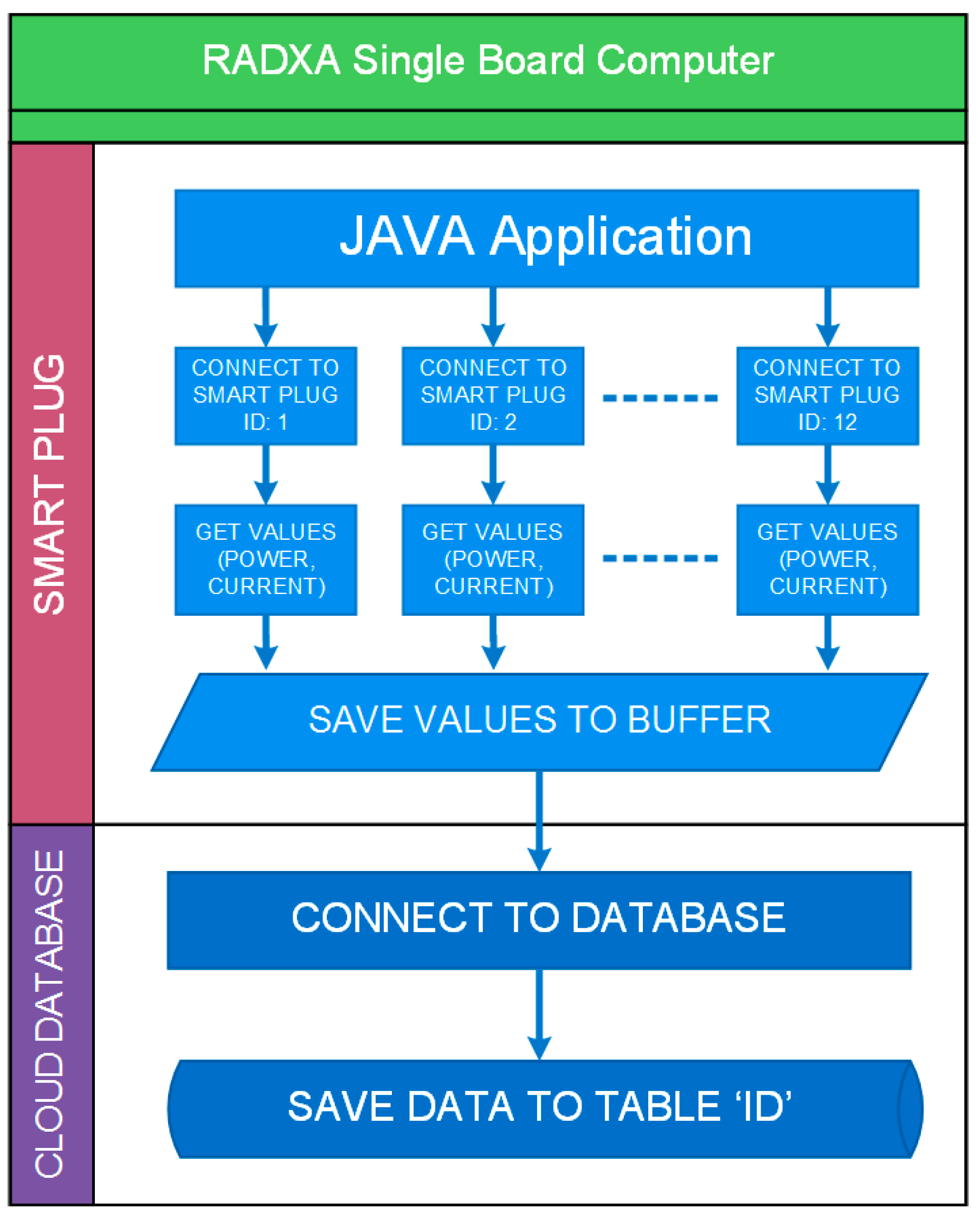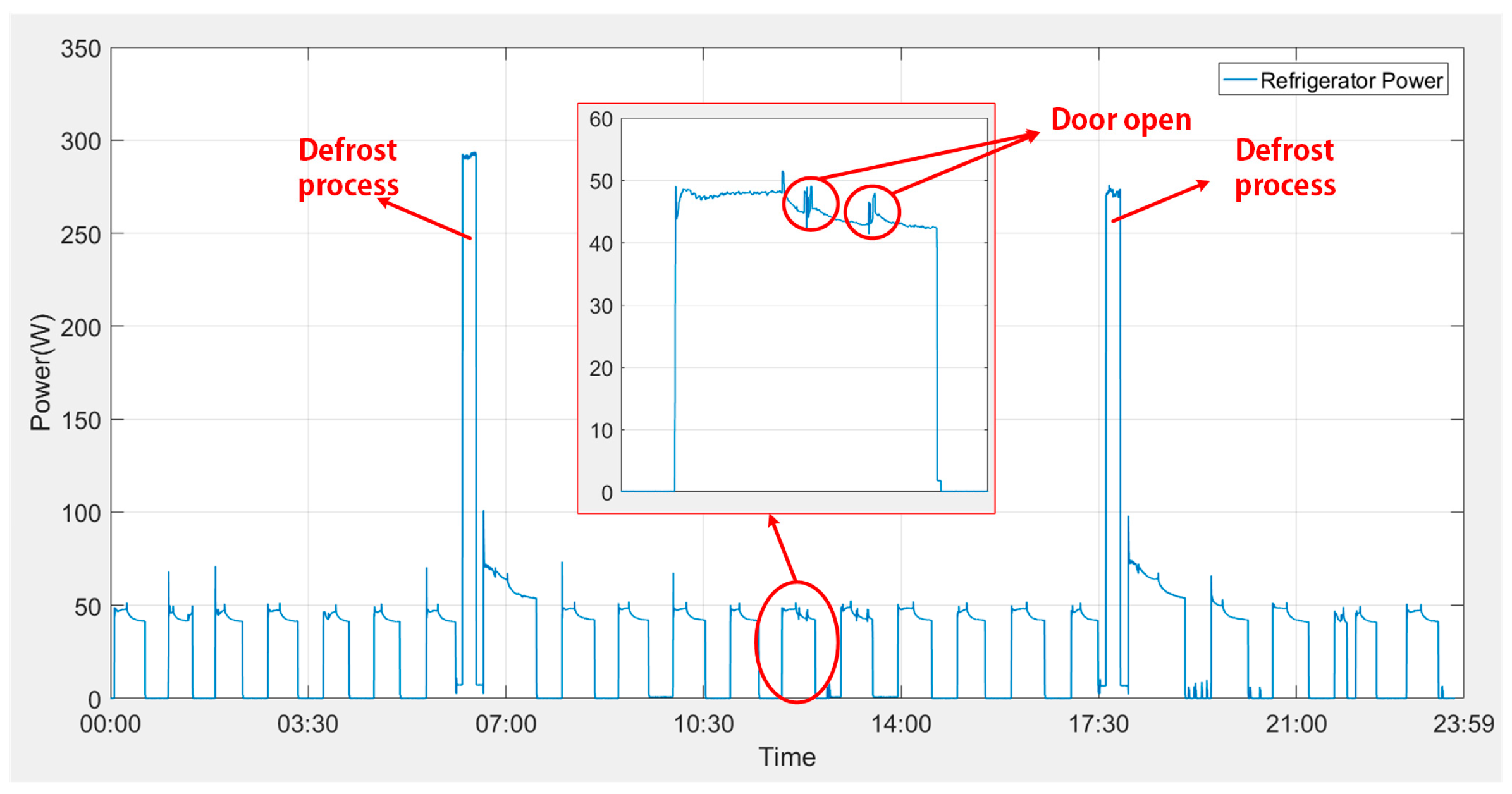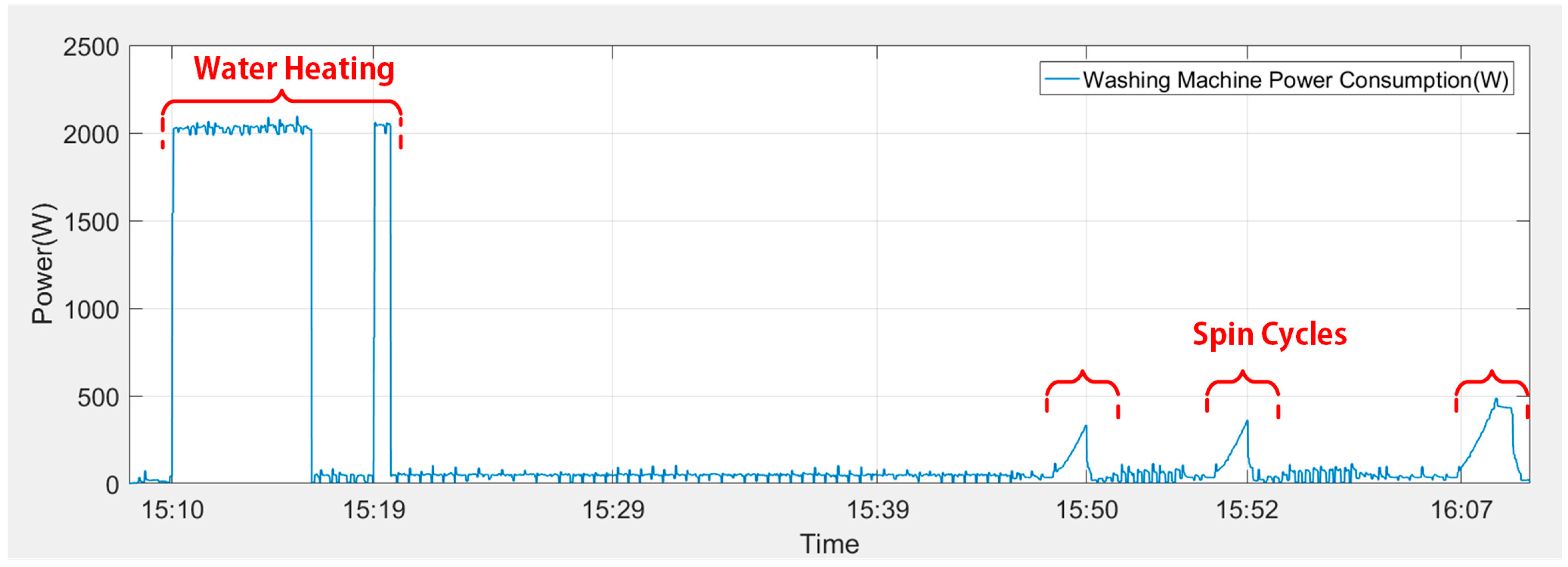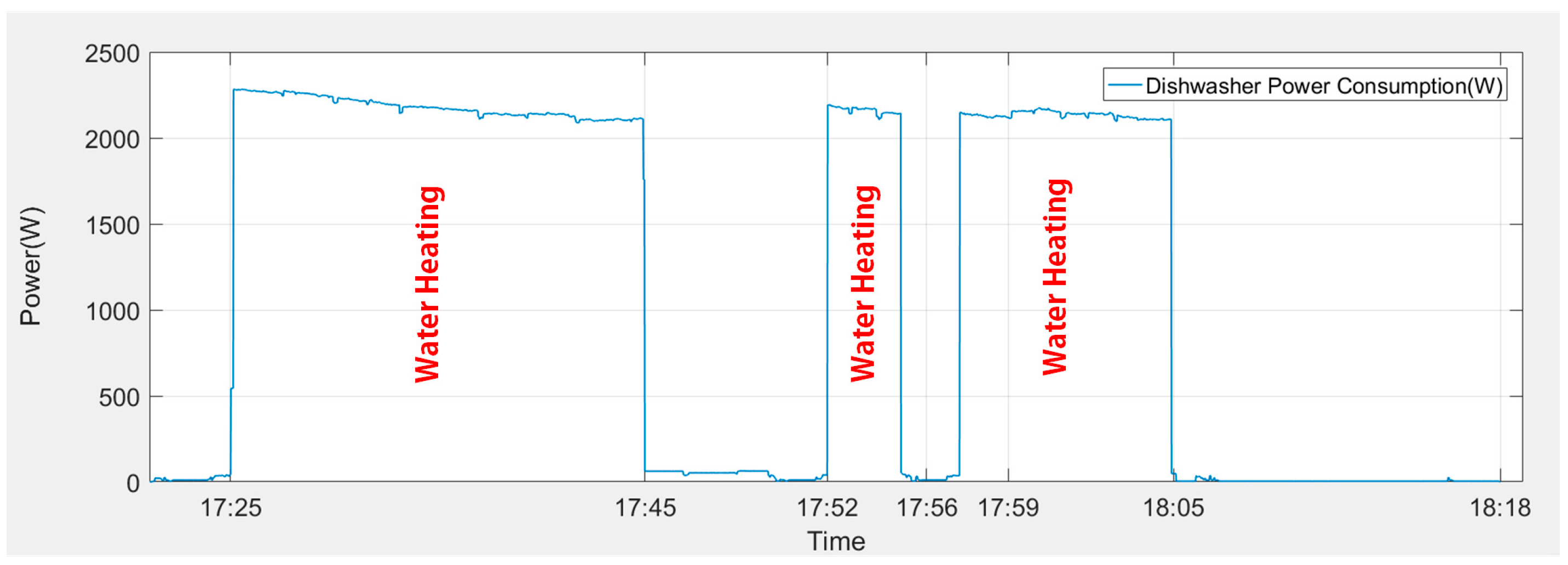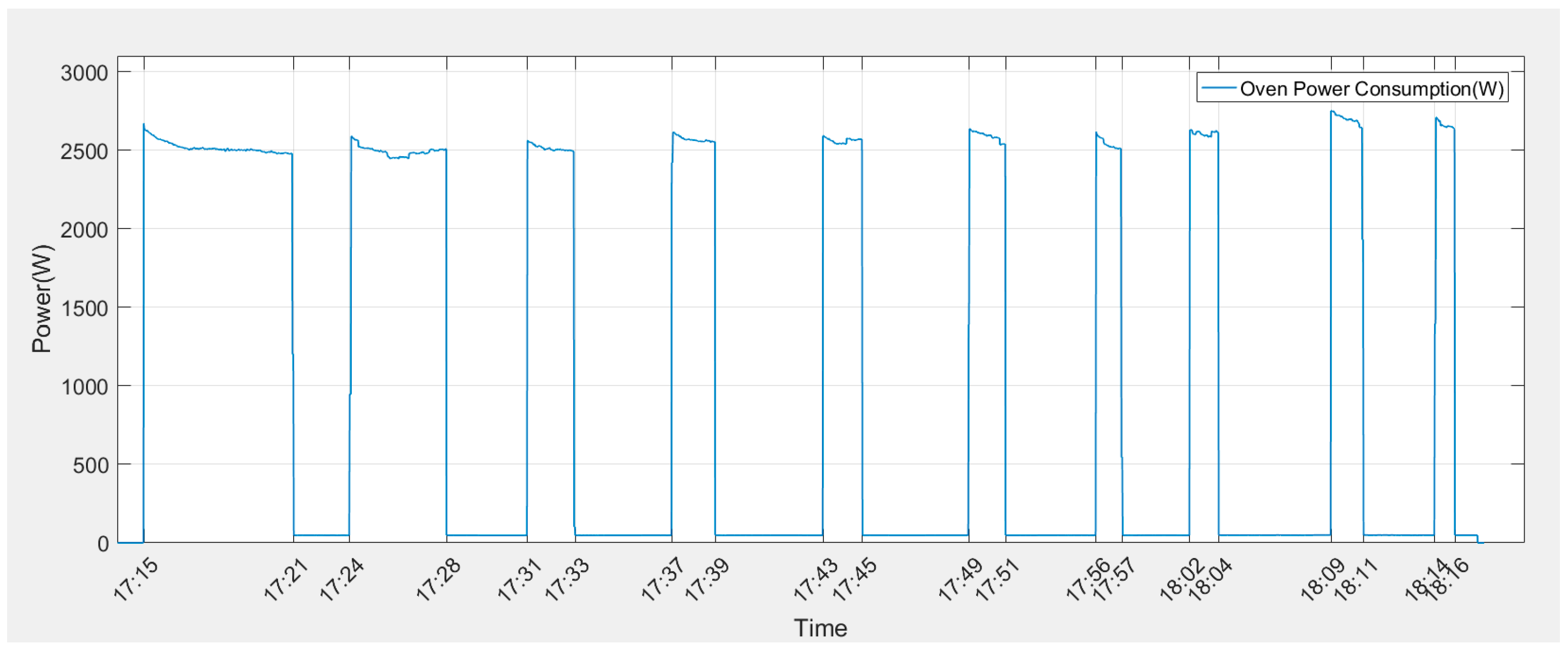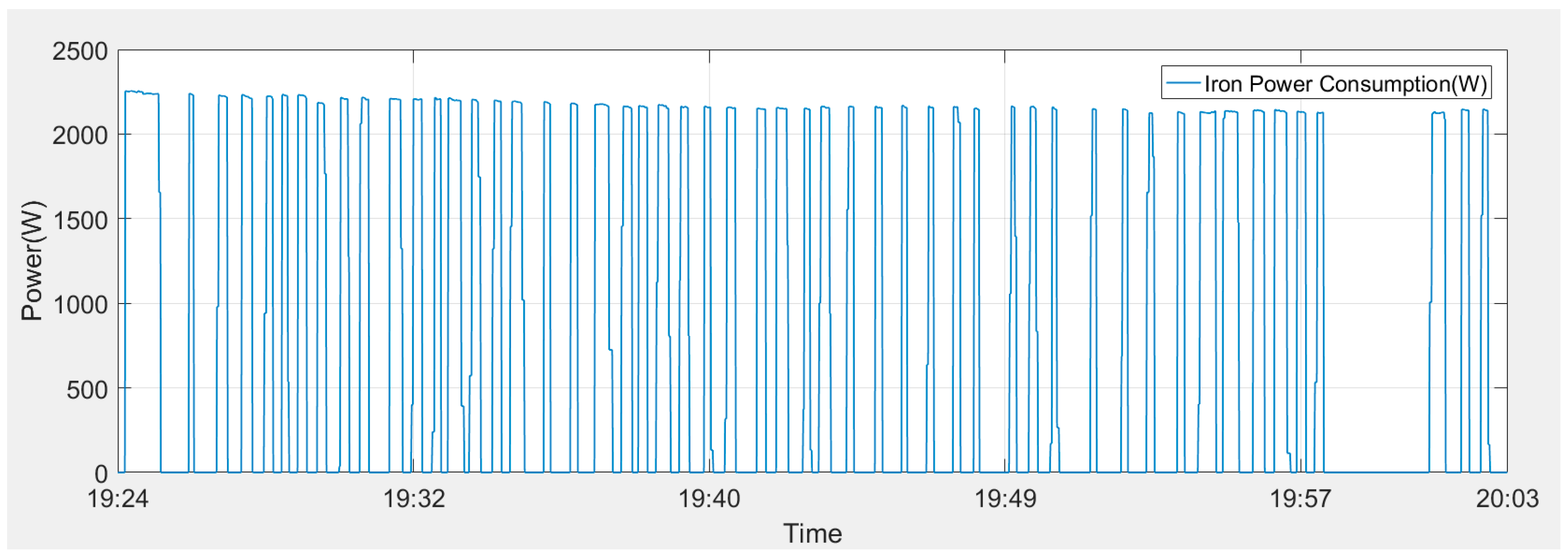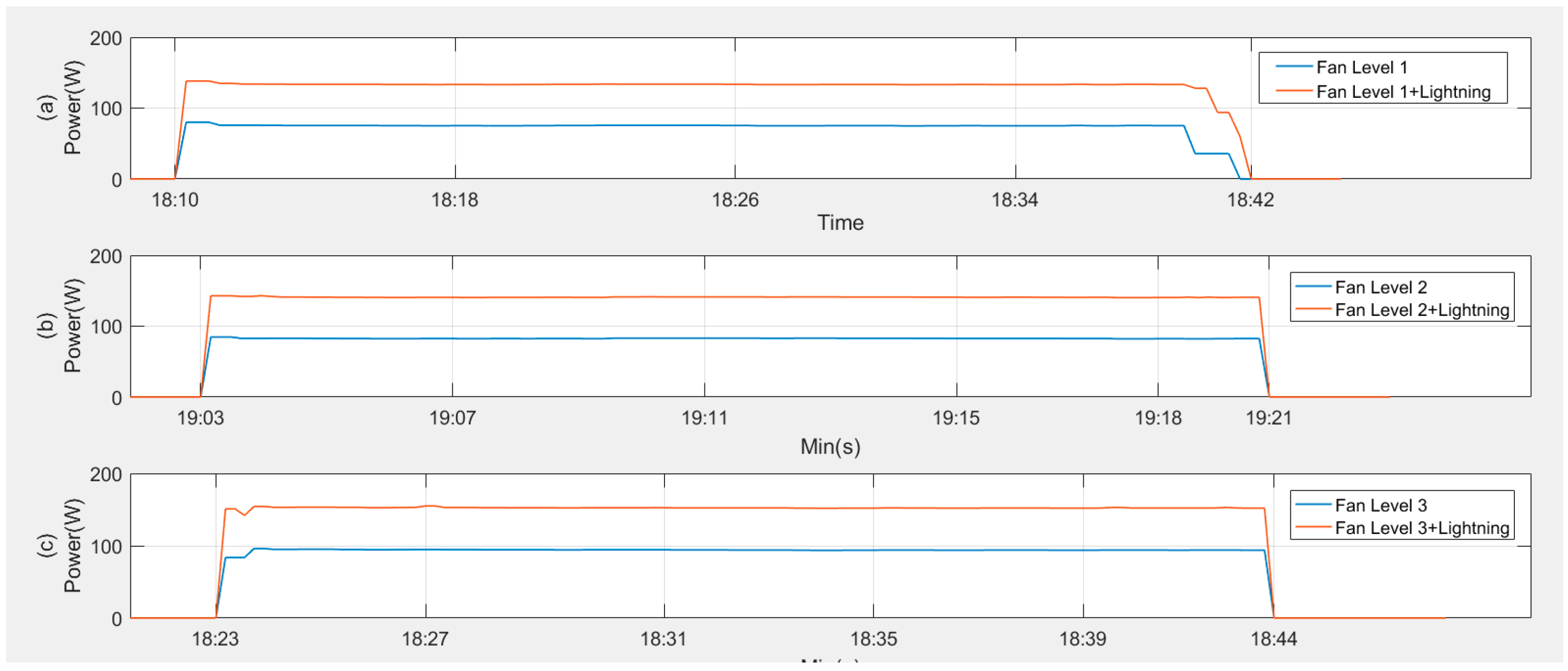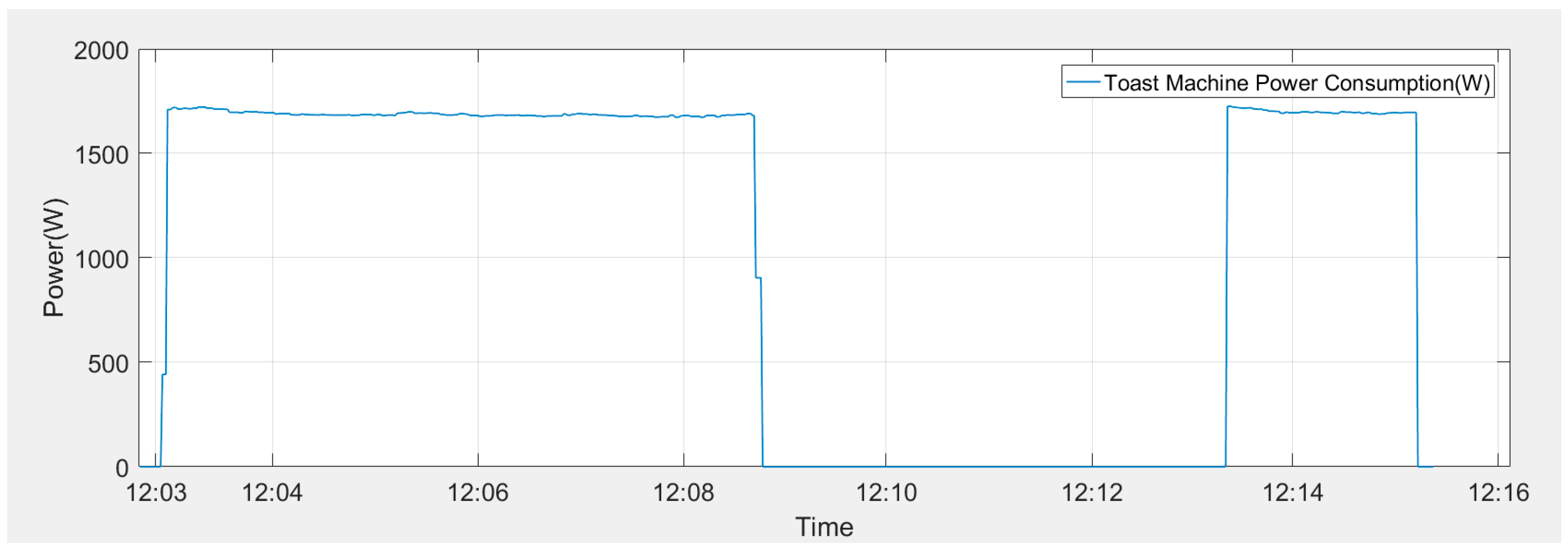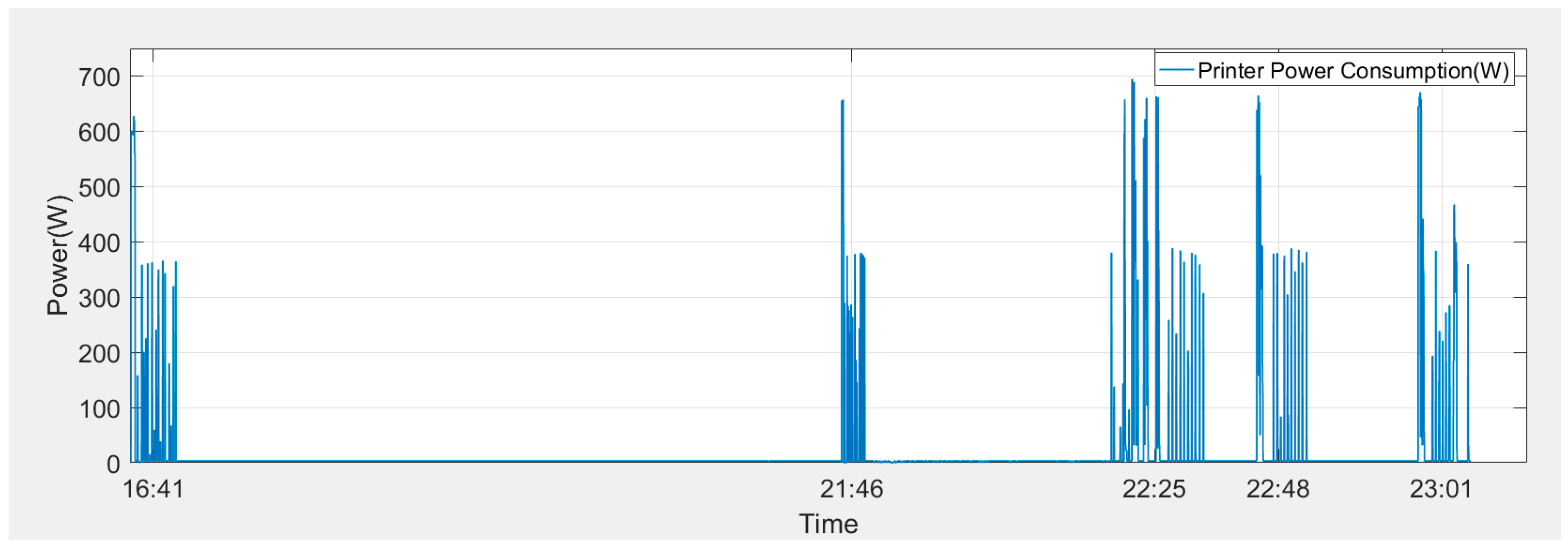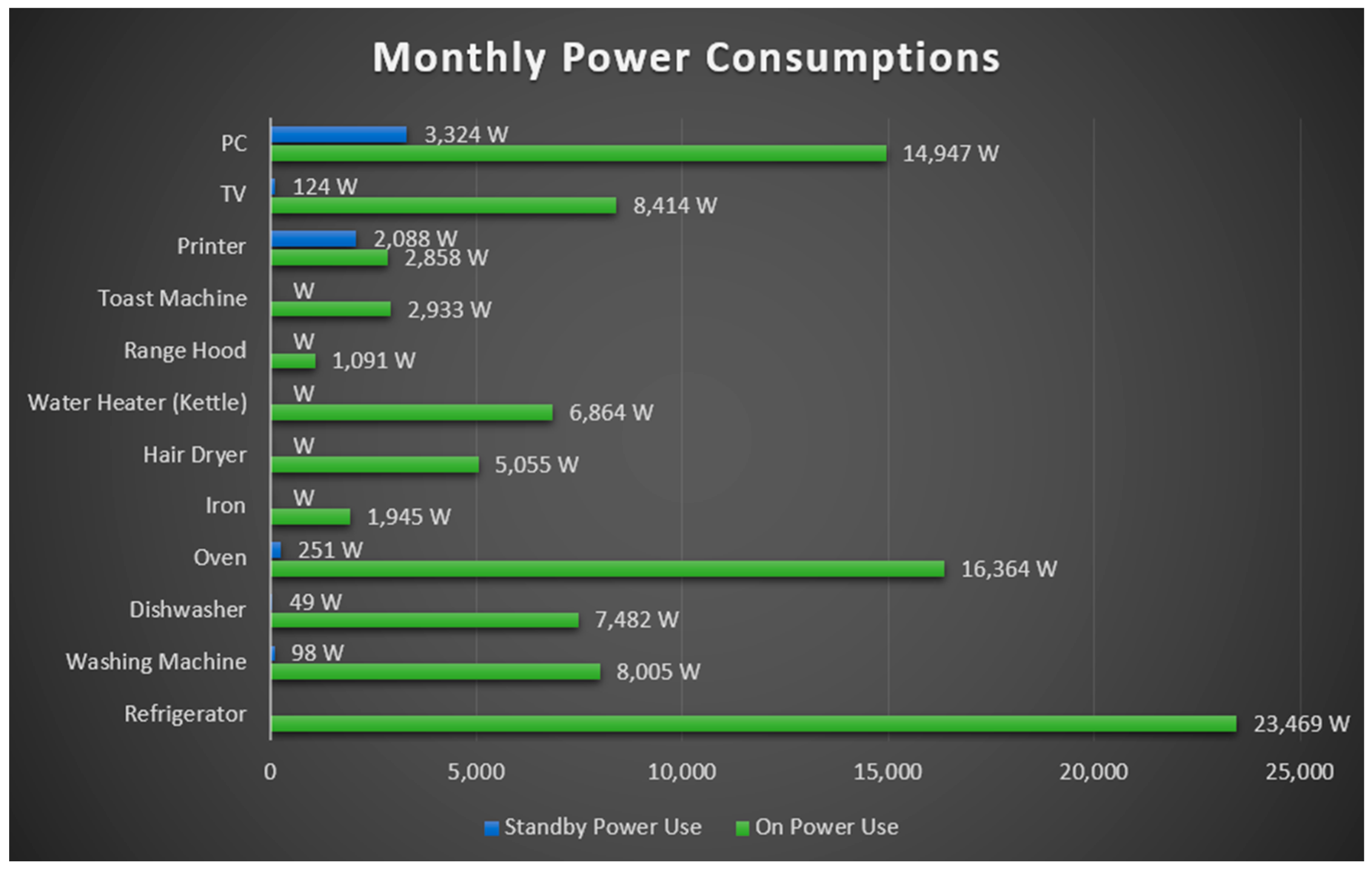1. Introduction
Smart grids (SGs) that attract intensive attention are reliable power grids having self-healing ability, comprising the consumers producing their own energy based on renewable energy sources with minimum cost and allowing the use of available infrastructure with full capacity [
1,
2,
3,
4]. In addition, SGs give the opportunity for consumers to operate demand response programs independently so that the optimal matching between source and load can be spread to each region of the horizontal time axis by considering consumer habits. In the beginning, demand response was supposed as a change in normal consumption demand taking into account the decrease or increase of the electrical energy production [
5]. Initial demand response programs were used to control loads at peak times in the United States [
6]. Demand response programs, considered as a power system resource and an essential part of SGs currently, bring economic benefits to the consumers and utility by spreading the consumption of electrical loads to the time axis, and they also enhance the reliability and sustainability of power grids [
6,
7]. In many countries, incentives are given directly or indirectly to encourage the use of demand response programs. Dynamic demand response programs were accepted by the European Union as a strategic tool to achieve three main objectives, which are reducing greenhouse gases by 20%, increasing the energy production based on renewable energy sources by 20%, and increasing energy efficiency by 20% [
8]. Although the electricity consumed in buildings varies from country to country, it is equal to 30–40% of the total electricity consumption all over the world [
9]. According to the data by the Turkish Statistical Institute, the electricity which is consumed by houses and commercial and government buildings approximately constitutes 45% of overall energy consumption in Turkey [
10]. While industrial and commercial buildings make use of demand response opportunities all around the world, the vast majority of residential buildings cannot use these opportunities [
11]. It is the opinion that dwelling comfort may be reduced and energy consumption habits are the biggest obstacle for the implementation of demand respond programs at homes [
12]. However, intelligent home energy management systems have gained popularity in recent years with the aim of enhancing the dwelling comfort in parallel with the advances in information and internet technologies [
13,
14]. Therefore, home energy management studies play a crucial role in enabling demand response programs to be used effectively in residences [
15].
The determination of residential load profile and electric power consumption has an effect upon the accuracy of demand response studies. Thus, several methods were used to generate the load profile and power consumption of home appliances precisely [
16,
17,
18,
19]. The bottom-up approach is often used to generate real electricity consumption data of a residence in the literature [
20]. The most important disadvantage of the bottom-up approach is that it needs the detailed load consumption data [
21]. To date, in many publications, representative data and statistical averages of the consumption of electrical appliances have been used to overcome this problem. Ref. [
22] classified the buildings in Singapore based on their energy consumption and built their mathematical models and load profiles using the bottom-up model. Then, the produced load models were compared with real models and they classified the houses by the number of rooms they had. Abeykoon V. et al. described the electrical home appliances using machine learning algorithms with the information gathered from power consumption data of home appliances with fast and high precision [
23]. This modeling was accomplished for the vast majority of the devices, but there is a need for more sample consumption and training of the algorithm in order to achieve the same success in the devices that contain complex operating modes. Pipattanasomporn M. et al. specified load profiles based on the power consumption data for the specified home appliances and described the demand management potentials of these loads. Although the major electrical appliances used in the two separate houses were determined as data sources in this study, the number of these appliances can be inadequate as a source for demand response studies. In [
17], the monthly power consumption of home appliances was predicted using a multiple regression model. In addition, the effect of seasonal variation on the monthly power consumption was examined. In 2007, the power consumption of home appliances in 72 dwellings was monitored for over two years and the data was recorded in five-minute intervals [
24]. The results of the study showed that the energy consumption increased by 4.5% in the second year due to an increase in the appliances that were left in standby mode. Munhaw K. et al. designed a measurement and control system for the power consumption of home appliances [
25]. The developed prototype suggests that home appliances can be controlled effectively by pursuing the electricity tariff prices. The results of literary reviews show that the information based on the load profiles and power consumption of home appliances is used extensively in many fields such as demand management, energy efficiency, determination of load usage trends, etc.
There are few studies focusing on the data for the power consumption and specific load profiles with high resolution of home appliances which is required in many areas. This is the main reason why the standard load profile and the average electricity consumption of home appliances were used in previous years. With the advent of SGs, more realistic load profiles and power consumption data are needed in the distribution system. The main purpose of this work is to meet the detailed power consumption data and describe load profiles of all operating modes of home appliances with different operating modes. In addition, this study aims to demonstrate demand management opportunities and the impact of standby consumption on energy efficiency by analyzing the obtained data. For this purpose, the power consumption data of 12 different home appliances used by a two-person family living in Çankırı, Turkey was recorded with high time resolution in one-second intervals from October to December 2016. A special measurement system composed of wireless power measurement plugs and a minicomputer was designed. The detailed power consumption of the home appliances was analyzed and the load profiles were created by taking different utilization modes of the devices into account. The obtained data is essential considering they can constitute a complete source of accurate and precise identification of electrical home appliances in residential energy management studies. Therefore, this paper is unique research demonstrating energy use behaviors of a two-person family in the climate and geographical conditions of Çankırı.
3. Numerical Results
In this section, the results of the power consumption measurements of the specified home appliances are discussed in detail for each device considering different operating modes. The data recorded for three months (from October to December 2016) and a detailed assessment was visualized by consumption data in November 2016 and dealt with in this section. The power consumption data for the remaining months except November is given and the accuracy of the measurements was verified by the residential electricity bill.
Refrigerator: The refrigerator was dealt with primarily and the daily power consumption of the refrigerator was depicted in detail in
Figure 4. The refrigerator was operating for cooling at certain intervals during the day and its energy consumption during a cooling process was determined as approximately 46 W/h. The total cooling time per day was roughly measured as 13 h and 28 min. When
Figure 4 is examined, it is seen that the refrigerator performs defrosting twice for 15 min each time and consumes approximately 280 W during a defrosting process. The daily consumption effect of the defrosting process was measured as 140 W. The hourly and daily average power consumption of the refrigerator were found as 32.61 W and 782.64 W, respectively.
To obtain the detailed power consumption data taking into account the opening of the door of the refrigerator, the change of power consumption was given in
Figure 4 and
Figure 5. In
Figure 5, the time–area of the refrigerator’s opening 5 times is considered in detail. On the first opening, the door of the refrigerator was left open for 30 s. After the door was closed again, the refrigerator operated the fan motor for 1 min and expended approximately 4.1 W during this process. When the door was opened for the second time, the duration of opening time was 5 s and the effect on power consumption was measured as 3.84 W/h. The refrigerator’s door was opened for 15 s for the third times and the effect on the hourly power consumption was measured as 4.4 W/h. In the fourth and fifth openings of the door, the power consumption was determined as 4.02 W/h and 3.96 W/h, respectively. It was observed that the refrigerator’s door was opened 15 times and for 15 s on an average day in this home. According to these assumptions, due to the opening of the door, the refrigerator consumed 0.25 W power for each time and this value corresponded to 3.75 W in the daily power consumption.
Washing Machine: The power consumed by the washing machine, which has 8 kg capacity, was measured and recorded in different washing programs. The results showed that consumers needed the washing machine using different washing modes three times in a week with full loads. We firstly investigated the cotton and synthetics wash programs at 40 °C. The duration of this washing program was 2 h and 6 min, and the heater of the machine worked to raise the water temperature to 40 °C during 1/4 of the washing time. Using the heater during operation time, the power consumption was determined as 961.09 W and the total power consumption of the machine was recorded as 1064.21 W for this washing option. It was easily calculated that the hourly power consumption of the washing machine was 506.77 W in washing conditions. It was observed that roughly 90.3% of the power consumption of the washing machine was caused by the water heater. The determination of time period for water heating was acquired from the recorded data. The data obtained from the washing modes is indicated in
Figure 6.
Afterwards, we examined the mixed washing program at 30 °C. In this option, the washing time lasted 1 h and 1 min, and the total power consumed by the machine during the washing was measured as 286.19 W. The large part of the power consumption was constituted by the heater to raise the water temperature to 30 °C, similar to the previous operation mode. In this operation program, the power consumed by the heater was determined as 234.46 W. This rate corresponded to 81.9% of the total power consumption.
Figure 7 shows the power consumption curve of the washing process for the 30 °C mixed washing program.
The last washing program preferred by consumers in a week was the mixed washing program at 40 °C. The washing time lasted for 1 h and 6 min. During this washing process, the total power consumed by the machine was measured as 713.11 W. The amount of power consumed in the heating process was determined as 650.97 W and this power constituted 91.2% of the total power consumption.
Figure 8 depicts the power consumption curve of the washing process for the 40 °C mixed washing program.
Dishwasher: The frequency of use of the dishwasher and the total power consumption was determined. When the usage samples of the dishwasher were examined, it was found that two washing programs were generally preferred in the home. The first washing program was the 55 °C economy program in which dishes were washed for a long time. The washing time of this program was 3 h and 11 min. The dishwasher consumed 871.97 W of power throughout this program. The water heating cycle lasted for a total of 22 min and consumed approximately 774.33 W for the heating. The ratio of the energy consumed in the heating cycle to the total energy was calculated as 88%.
Figure 9 demonstrates the power consumption curve of the 55 °C economy program.
The other washing program was the 65 °C power mode program. In this program, the washing time took 56 min. This operation time was shorter than the 55 °C economy program by about 3 times, and the water temperature reached the desired temperature in 31 min. The amount of energy used for water heating increased considerably, because the water temperature was increased in a short time compared to the 55 °C economy program. The amount of power consumed during the heating time was measured as 1113.46 W and the total amount of power consumed by the dishwasher was recorded as 1125.2 W. When the obtained data was evaluated, 98.9% of the power was spent for water heating. The energy consumption curve of the dishwasher in the 65 °C power program is shown in
Figure 10. When
Figure 9 and
Figure 10 are compared,
Figure 10 shows that the water heating consumption is too much despite the washing time being much shorter. It can be explained by the fact that water has to heat 10 degrees more in power mode in a period 3 times shorter than the economy mode.
Oven: Another home appliance that plays a significant role in energy consumption in the home is an oven. When the usage samples of the oven were examined, it was observed that the household needed to cook with the oven for three times at 180 °C and once at 150 °C on average within a week. The power consumption curve of the oven is shown in
Figure 11, if the consumer chooses the 180 °C temperature for baking, taking 1 h and 2 min. When the oven was operated, the heating resistor remained on for a long time and then it was switched off when the oven temperature reached an adequate level. Therefore, the power consumption was very high. While the heating resistor did not operate, the oven only needed power to perform lighting. The heating resistor was switched on occasionally until the cooking process was completed, keeping the temperature of the oven at the desired value. The heating resistor remained active for 24 min and 50 s in this cooking process and the total power consumption of the heating resistor was measured as 947.49 W during the baking interval. The sum of the time when the heating resistor was not in operation was obtained as 38 min and 27 s. The power consumed by the oven for lighting, fan, and other electronic components was calculated as 104.96 W with the heating resistor switched off. The total amount of power that the oven spent was measured as 1052.45 W during the cooking period. If lighting and other energy-consuming components were considered to be in operation during heating, the heating resistor consumed approximately 842.53 W of power, which equaled to 80.05% of the total power consumed.
Iron: An iron with three temperature scales for the ironing of different cloths was analyzed, and the consumer generally preferred to use it at the temperature level 2. The average time for ironing was measured as 38.5 min a day per week. If
Figure 12 depicting the power consumption curve of the iron is examined, the heating and standby cycles can be seen. Considering an ordinary ironing time, it was observed that the heating worked for about 15 min and waited for 23 min. The total power consumed in this ironing period was 486.3 W.
Hair Dryer: The other selected device was a hair dryer. The power consumption data belonging to the hair dryer was measured and recorded. The results of the measurements showed that the hair dryer was used for 2 min in high-speed blowing mode every day and 3 times in a week for an additional 11 min. Slow-speed blowing mode usage of the hair dryer did not present, because the users never used this mode in November 2016. If the average frequency of the usage of the hair dryer was calculated, the weekly total duration was found to be approximately 43 min. The weekly average power consumption of the hair dryer was calculated to be 1263.77 W.
Figure 13 shows the power consumption curve of the hair dryer in high-speed blowing mode for one usage period.
Kettle: Another home appliance evaluated was a kettle needed frequently in the kitchen. Although the kettle had the ability to heat the total two liters of water, it was observed that the investigated household utilized it to heat up to 0.5 liters of water generally. The kettle boiled 0.5 liters of water in approximately 1 min 53 s and in this duration the consumed power was 66.56 W. In addition, when the amount of water in the kettle was 1 L and 1.5 L, the time needed to boil the water was recorded as 3 min 17 s and 4 min 30 s, respectively. The power consumed for these processes was measured as 104.84 W and 155.06 W, respectively.
Figure 14 depicts the power consumption curve of the kettle used with different amounts of water.
Range Hood: One of the major devices in the kitchen is a range hood. In the home where the energy analysis was done, the range hood with 3 different fan speeds was operated under the fan speed level 3 generally. The operation time of the range hood using the fan speed level 3 was determined as 3 h 11 min in total in a week. The power consumption data and the operation times for the different fan speeds of the range hood in a week were determined. The range hood whose fan speed was adjusted at level 1 was run two times in a week for about 34 min without lighting, and its average power consumption was measured as 41.79 W per run. When the fan speed of the range hood was at level 2, it was detected to be used for 18 min once a week and the power consumption was measured as 24.82 W. At level 3, the highest level of fan speed, the range hood was utilized for an average of 18 min, 5 times a week, and it consumed 32.88 W of power for each use. The hourly consumption values of the range hood were determined as 73.76 W for fan speed level 1, 82.75 W for level 2, and 93.95 W for level 3. The range hood consumed 0.96 W of power per min and 58.15 W of power per hour for lighting.
Figure 15 shows the power consumption graphs for different fan speeds of the range hood with and without lighting.
Toast Machine: Another home appliance analyzed in terms of power consumption and usage frequency was a toast machine. The results of the measurements show that the consumers utilized the toast machine 14 times in a month at the highest heating level. It was seen that the toast machine was used for an average of 13 min and it only consumed power during 7 min 44 s for each use. During the working period, the total energy consumption was measured as 209.47 W. The power consumption of the toast machine was calculated as 2932.58 W monthly.
Figure 16 depicts the average power consumption curve of the toast machine for each use.
Television: Another home appliance analyzed concerning load profile and power consumption was a television with LED panel. The television power consumption can reveal the television watching habits of the household. It was found that the duration of the television watching was different on weekdays and weekends. The household watched the television for 6 h and 33 min during the weekdays. It was shown that color change in the image and tracking down channel change cases affected the television power consumption. The average power consumption during the hourly watching period was measured as 54.64 W. If the television is switched off from the remote control only, the television continues the power consumption throughout standby mode with its video panel closed. From the moment the television was turned off using the remote control only, it consumed 18.69 W for 10 min on average. In addition, the television power consumption was measured as 376.58 W per day on the weekend, and the power consumed during standby period composed 0.5% of total consumption.
Figure 17 illustrates the power consumption graph regarding a day of the weekend.
Computer: A desktop computer is another device frequently used during a day in the house and one we analyzed in terms of energy utilization. The computer’s average daily usage measured as 2 h and 14 min with peripheral devices, which included a standard box, a desktop speaker, and two LCD monitors, one 19” and the other one 24”. The power consumed by the computer in standby mode was measured as 5.09 W per hour and never taken to sleep mode. It was calculated that this value caused 110.79 W per day of power consumption and 3323.7 W per month of power consumption in standby mode. The average hourly power consumption of the computer during operation and total power consumption for one day of use were measured as 173.48 W and 387.4 W, respectively. The computer consumed a total of 14,946.6 W power per month and about 22% of this power was depleted while the computer was in standby mode.
Figure 18 depicts the power consumption curve of the computer throughout the utilization time.
Printer: The last device analyzed was a laser printer. Although the laser printer power consumption is related to its usage frequency, this power consumption was found to be 44.05 W daily on average for the home investigated. The average utilization time of the printer corresponded to 7 min 53 s per day. The example of the power consumption during the day is given in
Figure 19. The remarkable point in the energy consumption of the printer is that the printer consumes in standby mode about 3 W per hour and this value equals to 2153.4 W of power consumption for a month. If the printer is plugged in constantly, the energy consumed in standby mode is about 3 times the energy used in running for daily work. The results exhibited that the printer consumed power equal to about 2858.2 W per month.
4. Assessment of Energy Consumption
After the power consumption values of the home appliances were recorded with high resolution, the evaluation of the data was made. The usage frequency of each device was recorded daily, weekly, and monthly and their utilization ratios in
Table 2 were determined considering the operating frequencies of these devices for November.
As the measurement periods have one-second resolution, the total working time of each device is taken as seconds and the total amount of power consumed in each usage based on the hourly power consumption data is found. The monthly power consumption of each device can be calculated using Equation (1) considering their usage frequency and power values.
In the Equation (1), P
Measured (
), Duration (
), and Density (
) represent the amount of hourly power, the total operating time, and the usage frequency of devices, respectively. The usage frequency was categorized daily, weekly, and monthly for each device and their usage density was found by using Equation (2).
In addition, it was discovered that some devices consumed energy in the standby mode, and the amount of unnecessary energy was calculated by using Equation (3) per month.
where P
Measured-StanBy (
) stands for the power consumption value in the standby mode. The total power consumption of the home appliances is approximately calculated at 99.4 kW for November. The electricity bill in November 2016 showed that the actual power consumption of the dwelling was 124.4 kW and this result proved the measurement accuracy. The difference between the real consumption and the measurement results represents the power needed by lighting, combi boiler, and low-power devices which was excluded.
Table 3 shows the total power consumption of the home appliances for three months.
Table 4 shows how the power consumption of each home appliance impacts total power consumption from October to December.
When the results from
Table 3 were analyzed, the monthly power consumption was calculated as 121.41 kW on average for the family comprising two persons. In addition, to determine how much energy the consumers use at what time of day, a day was allocated 3 parts according to the energy tariff policy applied in Turkey. Considering this classification, the hours between 06.00 am and 17.00 pm were the daylight tariff part, the hours between 17.00 pm and 22.00 pm were the peak tariff part, and the hours between 22.00 pm and 06.00 am were the night tariff part. When the home energy consumption was classified according to the three mentioned parts, it was seen that the daytime consumption amount for November and December was higher than the others and the amount of demand consumption for October was more than the other energy tariff times. In addition, peak usage of the three months took place in December. This result can be attributed to increased combi boiler usage excluded in the test depending on drops in temperature in December.
Table 5 indicates how often power is used in energy tariff periods for each month.
Finally, the home appliances that consume energy in standby mode were investigated to improve energy efficiency. It was determined that the computer, television, printer, oven, dishwasher, and washing machine consumed energy in standby mode.
Figure 20 shows the ratio of total and standby power usage for November 2016. Standby energy use for that month was up to 4.7% of the total energy.


